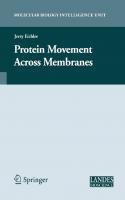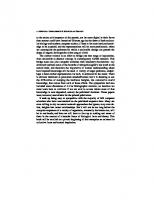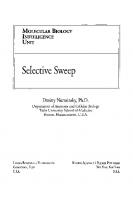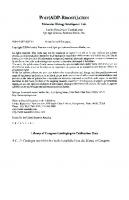Nuclear Import and Export in Plants and Animals (Molecular Biology Intelligence Unit) 030648241X, 9780306482410
Nuclear Import and Export in Plants and Animals provides insight into the remarkable mechanisms of nuclear import and ex
153 8 16MB
English Pages 244 [239] Year 2005
Recommend Papers

- Author / Uploaded
- Tzvi Tzfira
- Vitaly Citovsky
File loading please wait...
Citation preview
MOLECULAR BIOLOGY INTELUGENCE UNIT
Nuclear Import and Export in Plants and Animals Tzvi Tzfira, Ph.D. Vitaly Citovsky, Ph.D. Department of Biochemistry and Cell BiologyState University of New York at Stony Brook Stony Brook, New York, U.S.A.
L A N D E S B I O S C I E N C E / EUREKAH.COM
GEORGETOWN, TEXAS
USA
KLUWER ACADEMIC / PLENUM PUBLISHERS NEW YORK, NEW YORK
U.SA
NUCLEAR IMPORT AND EXPORT IN PLANTS AND ANIMALS Molecular Biology Intelligence Unit Landes Bioscience / Eurekah.com Kluwer Academic / Plenum Publishers Copyright ©2005 Eurekah.com and Kluwer Academic / Plenum Publishers All rights reserved. No part of this book may be reproduced or transmitted in any form or by any means, electronic or mechanical, including photocopy, recording, or any information storage and retrieval system, without permission in writing from the publisher, with the exception of any material supplied specifically for the purpose of being entered and executed on a computer system; for exclusive use by the Purchaser of the work. Printed in the U.S A. Kluwer Academic / Plenum Publishers, 233 Spring Street, New York, New York 10013, U.S A. http://www.wkap.nl/ Please address all inquiries to the Publishers: Landes Bioscience / Eurekah.com, 810 South Church Street, Georgetown, Texas 78626, U.S.A. Phone: 512/ 863 7762; FAX: 512/ 863 0081 http://www.eurekah.com http://www.landesbioscience.com Nuclear Import and Export in Plants andAnimalsy edited by Tzvi Tzfira and Vitaly Citovsky, Landes / Kluwer dual imprint / Landes series: Molecular Biology Intelligence Unit. ISBN: 0-306-48241-X While the authors, editors and publisher believe that drug selection and dosage and the specifications and usage of equipment and devices, as set forth in this book, are in accord with current recommendations and practice at the time of publication, they make no warranty, expressed or implied, with respect to material described in this book. In view of the ongoing research, equipment development, changes in governmental regulations and the rapid accumulation of information relating to the biomedical sciences, the reader is urged to carefully review and evaluate the information provided herein.
Library of Congress Cataloging-in-Publication Data Nuclear import and export in plants and animals / [edited by] Tzvi Tzfira, Vitaly Citovsky. p.; cm. ~ (Molecular biology inteUigence unit) Includes bibliographical references and index. ISBN 0-306-48241-X 1. Nuclear membranes. 2. Biological transport. 3. Proteins—Physiological transport. [DNLM: 1. Nucleocytoplasmic Transport Proteins—genetics. 2. Active Transport, Cell Nucleus—physiology. QU 55 N9627 2005] I. Tzfira, Tzvi. II. Citovsky, Vitaly. Ill, Series: Molecular biology intelligence unit (Unnumbered) QH601.2.N843 2005 571.6'6-dc22 2005003124
This book is dedicated to our families.
CONTENTS Preface 1. Structure of the Nuclear Pore Michael Elhaum Structure and Assembly Molecular Dissection and Proteomics FG Repeats Transport Models in Relation to Structure The Minimal Pore Assembly Revisited
.XI
1 3 11 14 15 16 17
2. Integral Proteins of the Nuclear Pore Membrane Merav Cohen, Katherine L Wilson and Yosef Gruenhaum Yeast POMs Vertebrate POMs Cell Cycle Dynamics of the N P C Membrane Fusion and Nuclear Pore Formation
28
3. Subnuclear Trafficking and the Nuclear Matrix Iris Meier Nuclear Matrix Targeting Signals Regulated Nuclear Matrix Interaction Compromised Subnuclear Localization and Disease
35
4. Nuclear Import and Export Signals Toshihiro Sekimoto, Jun Katahira and Yoshihiro Yoneda Definition of Nuclear Import and Export Signals Basic Type NLSs Non-Basic Type NLSs NESs Recognized by Importin p Related Proteins Sequences Acting As Both NES and NLS 5. Nuclear Import of Plant Proteins Glenn R Hicks Protein Import in Animals and Yeast Nuclear Translocation in Plants Regulated Protein Import in Plant Development Recent Advances in Plant Nuclear Translocation
28 30 30 31
36 43 AA 50 50 51 53 53 55 61 61 62 71 7A
6. Nuclear Import of Agrobacterium T-DNA Tzvi Tzfira, Benoit Lacroix and Vitaly Citovsky The Genetic Transformation Process T-Complex Export to Plant Cells Molecular Structure of the Mature T-complex T-Complex Nuclear Import Host Cell Proteins That Interact with VirD2 and VirE2 VirE3, a Bacterial Substitute for the Host Protein VIPl A Model for T-DNA Nuclear Import and Intranuclear Transport 7. Regulation of Nuclear Import and Export of Proteins in Plants and Its Role in Light Signal Transduction Stefan Kircher, Thomas Merkky Eberhard Schdfer and Ferenc Nagji Nuclear Import of Proteins Nuclear Export of Proteins The Regulatory GTPase Ran Plant Factors and Plant-Specific Features of Nuclear Transport Regulation of Nuclear Transport As a Tool to Regulate Signaling Nucleocytoplasmic Partitioning in Light Signal Transduction 8. Nuclear Eiqport: Shuttling across the Nuclear Pore John A. Hanover and Dona C. Love The Nuclear Pore Complex (NPC) Methods for Analyzing Nuclear Export Rev-GR-GFP: Nuclear Export in Vitro The Nuclear Export Receptors (Karyopherins): Importins and Exportins A Nonclassical Export Receptor: Calreticidin Calcium-Dependent Modulation of Nuclear Transport? Mechanism of Nuclear Protein Export and Shuttling Export of RNA: Ribosomes, tRNA, snRNAand mRNA Chromatin Organization and Transcriptional Repression Export Machinery, Pre-mRNA Splicing, and Nonsense Mediated Decay 9. Nuclear Protein Import: Distinct Intracellular Receptors for DifFerentTypes of Import Substrates David A. Jans and Jade K. Forwood The Transport Process a Importins Importin [31 and Homologs Competition between Target Sequences/Receptors Distinct Nuclear Import Receptor for Different Types of TFs; Differential Regulation? Unanswered Questions
83 85 86 87 88 89 92 92
100 100 102 102 103 104 104 118 119 119 121 121 125 125 127 128 131 131
137 138 138 150 151 153 155
10. The Molecular Mechanisms of mRNA Export 161 Tetsuya TaurUy Mikiko C. Siomi and Haruhiko Siomi Ran Dependent Nucleocytoplasmic Transport 162 RanGTPase Dependent RNA Exports 163 Export of mRNA 163 From Gene to Nuclear Pore to Cytoplasm 165 TAP-Mediated mRNA Export: Ran Independent Nucleocytoplasmic Transport 165 An Adaptor Protein and Other Conserved mRNA Export Factors .... 166 Interactions between mRNA Export Machineries and Nucleoporins 167 Links between mRNA Quality Control and Nuclear Export 167 11. Nuclear Import and Export of MammaUan Viruses Michael Bukrinsky Transport to the Nuclear Envelope Interactions at the Nuclear Pore Export through the Nuclear Pore
175
12. Nuclear Import of DNA David A. Dean and Kerimi E. Gokay The Nuclear Envelope Is a Barrier to Gene Delivery Nuclear Import of DNAs in Non-Dividing Cells Plasmid Nuclear Import Nuclear Import of Plasmids in Cell-Free Systems Alternative Pathways for Plasmid Nuclear Uptake Viral Nuclear Import Nuclear Import of Single-Stranded DNA Nuclear Import of Oligonucleotides
187
13. Research Methodologies for the Investigation of Cell Nucleus Jose Omar Bustamante Methods
206
Index
176 177 179
187 189 189 195 196 197 199 199
207 225
1
i^JL>llUK5= Tzvi Tzfira Vitaly Citovsky Department of Biochemistiy and Cell Biology State University of New York at Stony Brook Stony Brook> New York, U.S.A. Chapter 6
nnwTTi
^Tii TnrrM> c
=v>vylM 1 ivJ Michael Bukrinsky Department of Microbiology and Tropical Medicine George Washington University Washington, DC, U.S.A. Chapter 11 Jose Omar Bustamante The Nuclear Physiology Lab and Nanobiotechnology Group Department of Physics, Universidade Federal de Sergipe The Brazilian Millenium Institute of Nanosciences The Brazilian Nanosciences & Nanotechnology Network Sao Cristovac, Brazil Chapter 13 Merav Cohen Department of Genetics The Institute of Life Sciences The Hebrew University of Jerusalem Jerusalem, Israel Chapter 2 David A. Dean Division of Pulmonary and Critical Care Medicine Northwestern Universitiy Medical School Chicago, Illinois,U.S.A. Chapter 12 Michael Elbaum Department of Materials and Interfaces Weizmann Institute of Science Rehovot, Israel Chapter 1
Jade K. Forwood Nuclear Signaling Laboratory Department of Biochemistry and Molecular Biology Monash University Clayton, Australia Chapter 9 Kerimi E. Gokay Division of Pulmonary and Critical Care Medicine Northwestern Universitiy Medical School Chicago, Illinois,U.S.A. Chapter 12 Yosef Gruenbaimi Department of Genetics The Institute of Life Sciences The Hebrew University of Jerusalem Jerusalem, Israel Chapter 2 John A. Hanover Laboratory of Cell Biochemistry and Biology NIDDK, National Institutes of Health Bethesda, Maryland, U.S.A. Chapter 8 Glenn R. Hicks Department of Botany and Plant Sciences Center for Plant Cell Biology University of California Riverside, California, U.S.A Chapter 5
=n
David A. Jans Department for Biochemistry and Molecular Biology Monash University Clayton, Australia Chapter 9
Ferenc Nagy Biological Research Center Plant Biology Institute, Szeged and Agricultural Biotechnology Center GodoUo, Hungary Chapter 7
Jun Katahira Department of Frontier Biosciences Graduate School of Frontier Biosciences Osaka University Suita, Osaka, Japan Chapter 4
Eberhard Schafer Institut fiir Biologic II/Botanik Universitat Freiburg Freiburg, Germany Chapter 7
Stefan Kircher Institut ftir Biologic II/Botanik Universitat Freiburg Freiburg, Germany Chapter?
Toshihiro Sekimoto Department of Cell Biology and Neuroscience Graduate School of Medicine Osaka University Suita, Japan Chapter 4
Benoit Lacroix Department of Biochemistry and Cell Biology State University of New York at Stony Brook Stony Brook, New York, U.S.A. Chapter 6
Haruhiko Siomi Institute for Genome Research Univertiy of Tokushima Tokushima, Japan Chapter 10
Dona C. Love Laboratory of Cell Biochemistry and Biology NIDDK, National Institutes of Health Bethesda, Maryland, U . S J \ . Chapter 8 Iris Meier Department of Plant Biology Plant Biotechnology Center Ohio State University Columbus, Ohio, U.SA. Chapter 3 Thomas Merkle Center for Biotechnology Universitat Bielefeld Bielefeld, Germany Chapter 7
Mikiko C. Siomi Institute for Genome Research Univertiy of Tokushima Tokushima, Japan Chapter 10 Tetsuya Taura Institute for Genome Research Univertiy of Tokushima Tokushima, Japan Chapter 10 Katherine L. Wilson Department of Cell Biology Johns Hopkins University of Medicine Baltimore, Maryland, U.S.A. Chapter 2 Yoshihiro Yoneda Department of Frontier Biosciences Graduate School of Frontier Biosciences Osaka University Suita, Osaka, Japan Chapter 4
PREFACE
T
he nucleus is perhaps the most complex organelle of the cell. The wide range of functions of the cell nucleus and its molecular components include packaging and maintaining the integrity of the cellular genetic material, generating messages to the protein synthesis machinery of the cell, assembling ribosome precursors and delivering them to the cell cytoplasm, and many more. As a complex machine, the nucleus maintains a constant two-way flow of information with the surrounding cytoplasm, such as import and export of ions, small and large proteins and protein complexes, and ribonucleoprotein particles. These transport processes occur through the nuclear pore complexes which represent the selective gateways through the nuclear envelope, a major barrier that isolates the nucleus from the cytoplasm. More than one hundred and seventy years have passed since Robert Brown discovered the cell nucleus using his simple light microscope, and, since then, remarkable progress has been made, both technically and conceptually, in studying and understanding the structure and function of the cell nucleus. In these days of modern cellular and molecular biology, we are capable of employing a vast array of sophisticated technologies and approaches to image the nucleus and its substructures, to isolate and functionally characterize its molecular components, and to modify the nuclear genetic material. With the resulting knowledge, we have come to appreciate the complexity of the nuclear struaure and function. In particular, the ability of various types of molecules to be actively transported through the well-guarded nuclear pore complexes is extremely intriguing. The chapters of this book provide insights into the intricate mechanisms of nuclear import and export. To better understand these processes, one must first elucidate the organization of the physical gateways into the nucleus. Thus, we begin this book with a detailed description of the nuclear pore structure and composition. The signal sequences that specify nuclear import and export of proteins are discussed next followed by eight chapters, each dedicated to a specific aspea of the nuclear import and export in plant and animal cells. Among these, special chapters are dedicated to nuclear import oiAgrobacterium T-DNA during plant genetic transformation, nuclear import and export of animal viruses, and nuclear intake of foreign DNA. A chapter on research methods to study nuclear transport concludes the book. The result is a compaa book which we hope the readers will find useful as a guide and a reference source for diverse aspects of nuclear import and export in plant and animal systems. We would like to express our sincere gratitude to all the authors for their outstanding contributions, to the stafFofEurekah.com for their help and patience during the long period of the book production and, in particular, to Ms. Cynthia Conomos for assistance in all technical aspects of the chapter productions. Tzvi Tzfira and Vitaly Citovsky January 2005, New York
CHAPTER 1
Structure of the Nuclear Pore Michael Elbaum
T
he nucleus is a defining hallmark in cells of all the higher organisms: yeast, animals, and plants. As the repository of the genome, it both encloses the chromatin and regulates its accessibility. It is also the site of nucleic acid synthesis, including replication of DNA, transcription and editing of messenger RNA, synthesis of ribosomal RNAs, and assembly of ribosomal subunits. By contrast, the cytoplasm is the site of protein synthesis, where functional ribosomes translate mRNA into polypeptides. The nuclear envelope defines the border between these two distina biochemical worlds. The nuclear pores (or nuclear pore complexes, NPCs) serve as guardians of this border, acting as the gateway for molecular exchange between the two major cellular compartments. They are deeply integrated to the physiological function of every cellular pathway involving communication between enzymatic, signaling, or regtdatory activities on one hand, and gene expression on the other. The nuclear pore complex is also a fascinating molecular machine, facilitating the passage of specific macromolecules in one direction while ferrying others in the opposite sense. The nuclear envelope (NE) defines the boundary between nucleus and cytoplasm. It is formed by two juxtaposed lipid bilayer membranes, the outer one of which is contiguous with the endoplasmic reticulum. The outer and inner lipid bilayers are also connected continuously through the nuclear pores themselves, though their protein compositions differ. A matrix of filaments underlies the inner nuclear membrane, providing mechanical support and anchoring sites for the enclosed chromatin. In animal cells these filaments are composed largely of lamins, similar in structure to intermediate filaments. Aside from a few known exceptions associated with viral infection, all molecular exchange across the nuclear envelope takes place via the nuclear pores, whose number ranges from many tens to several thousand per nucleus. Thus RNAs and ribosomal subunits are exported to the cytoplasm, while proteins needed in the nucleus must be imported, and often reexported when their task there is done. Each pore is a large multi-protein complex, consisting of 30 or more distinct protein components in multiple copies. Its total molecular weight has been measured at 125 MDa for vertebrate cells, and about 60 MDa for yeast. Individual nuclear pores are thought to mediate traffic in both directions. The functional task of the nuclear pore is to regulate entry to, and exit from, the nucleus. Specific pathways are discussed at greater depth in other chapters of this book. A degree of consensus has emerged in describing nuclear transport as a receptor-mediated translocation process. Molecular cargo is marked for import (or export) by the presence of peptide signals, which are then recognized by specific receptors that serve to usher the cargo across the pore. Models of translocation can been categorized into those that anticipate some form of micromechanical movement (for example iris-like closures) of the pore itself on one hand, ' or entirely biochemical sieves on the other. ^'^'^^ While deep modulation of calcium levels has a
Nuclear Import and Export in Plants and Animals, edited by Tzvi Tzfira and Vitaly Citovsky. ©2005 Eurekah.com and Kluwer Academic / Plenum Publishers.
Nuclear Import and Export in Plants and Animals
pronounced effect on nuclear pore structure in vitro,^ ^' calcium depletion does not appear to be coupled to nuclear transport regulation in intact cells.^^'^^ The lack of intrinsic ATPase activity in the nuclear pore supports the second, nonmechanical class of models. A rather minimalistic model for nucleocytoplasmic transport describes the nuclear pore and its associated soluble biochemistry as an affinity-regulated chemical pump. ' Two apparently distinct modes of transport are identified: small molecules including water, ions, metabolites, and even small proteins (up to -40 kDa molecular weight) can pass by simple diffusion so that their concentrations in solution equilibrate on the two sides of the NE; larger proteins and protein complexes are transported by an "active" mechanism that is able to pump the molecular cargo against a gradient in concentration, and so to accumulate it on one or the other side of the NE. In the latter case, proteins bearing nuclear localization signal (NLS) peptides associate with receptors of the importin/karyopherin family in the cytoplasm, and dissociate from them inside the nucleus. The canonical import receptor is importin P, also known as karyopherin p, '^^ or as p97. This receptor interacts with NLS via an importin a (karyopherin a) adapter protein, so that a single cargo molecide enters the nucleus as a heterotrimer with the receptors. Their dissociation is governed by a competitive interaction with the small GTPase Ran,^^'^^ which in its GTP form binds the importin P and releases the a molecule and the NLS-cargo.^'^^'^^'^'^ A differential concentration of RanGTP across the nuclear envelope is maintained by the localization of the associated GTP exchange factor RanGEF (independently known as the chromatin condensation factor RCCl) loosely bound to chromatin within the nucleus, and the GTPase activating protein RanGAP associated with the peripheral cytoplasmic structures of the NPC.^^'^^ Thus Ran is primarily in the GTP form within the nucleus, and in the GDP form in the cytoplasm.^^ Computer simulations support the assertion that receptor selectivity at the pore is sufficient for its fiinction as a molecular pump, in combination with the Ran cycle; specific transport directionality is not required. ' ^ In some cases the directionality of transport could be inverted by artificially inverting the RanGTP gradient. The same paradigm operates for export, except that the association of the cargo and RanGTP to the export receptor is synergistic rather than competitive. Transfer RNAs make use of a specific receptor for export,^^'^^ while export of other RNAs is thought to be governed by signals on associated proteins. In the case of large substrates a restructuring of the cargo itself may also be involved. A beautiftil example was observed by electron microscopy for Balbiani ring mRNA export in Chironomus salivary glands. A series of snapshots shows the spiral ring unwinding and feeding progressively through the pore.^^ The major role of the fixed structure of the NPC in such a model is to provide a selective translocation barrier, limiting passage to a rather short list of proteins. Those which are able to associate with signal-bearing molecular cargo, most notably importin p, are recognized as nucleocytoplasmic transport receptors, effectively opening the barrier to pass the complex where the cargo alone would be excluded. (It should not be overlooked that the transport receptors may have other roles in the cell as well.^ ) Within this picture the "active" transport is achieved primarily by the Ran switch, whose role is primarily to recycle the components of the chemical pump. No "moving parts" are required in the pore itself. A number of other proteins on the NPC s recognition list, particularly those involved in signal transduction such as p-catenin,^'^'^^ are able to pass pore autonomously. Their directionality and temporal accumulation are governed primarily by retention on nuclear or cytoplasmic structures, rather than by restriction of the reverse passage through the pore (reviewed in re£ 59). Perhaps the essential structural question is how the NPC can be so selective, passing relatively large cargo and complexes while blocking the passage of smaller ones. High selectivity normally implies a high and specific equilibrium affmity, but in the case of transport strong binding would of course be antithetical to translocation.
Structure of the Nuclear Pore
Structure and Assembly Nuclear pores have been studied since die early days of biological electron microscopy. ^" Several approaches and techniques have been pursued to determine their structure. Traditional sectioning of embedded nuclei shows the juxtaposed lipid membranes pinched at the edges of a hole approximately 50 nm in diameter. Close observation reveals some poorly-resolved structure on both the cytoplasmic and nuclear faces. Scanning electron microscopy provides a detailed relief view of these surfaces^^ while the introduction of field-emission sources enabled imaging at high resolution.^^'''^ Rotary shadowing in transmission electron microscopy can provide a similar level of detail.'^^'^ These surface views show a characteristic eight-fold rotational symmetry, with eight fibrils protruding into the cytoplasm, and eight fibers collected into a ring on the nucleoplasmic side, forming the nuclear basket. Atomic force microscopy shows similar surface structures at somewhat lower resolution, though with the advantage at least in some cases that imaging can be performed in hydrated, near-native conditions. ' ' Figure 1 shows a number of views of the nuclear pore. Between these peripheral fibrilar structures lies the central framework of the NPC. This domain was examined extensively by transmission electron microscopy.'^ ' ^ The favored sample has been the giant nucleus (germinal vesicle) present in oocytes oiXenopus laevisy though several studies have demonstrated a universality of the basic elements across many representative animal species.^'^^'^^ Oocyte nuclei can be extracted by hand under a simple dissecting microscope, and the nuclear envelope spread flat on a microscope grid. Computerized image processing methods may be used to orient and average the images of individual pores, thereby improving signal to noise. Image averaging emphasizes the common underlying features, while intrinsic variability is lost along with the noise. Thus eight-fold symmetry is emphasized, with density appearing in a pattern of radial spokes. The hints to the protruding filament structures are lost, due to their intrinsic disorder. A dense object appears at the center of the pore. Because of its strategic location this object has often been called the "central transporter". Comparison of the average with individual images shows that this object is highly variable, on the other hand, leading to suggestions that it may not be a distinct structiu*al feature of the pore itself but rather evidence of cargo caught in transit. Central protrusions appear with similar variability in scanning electron and atomic force microscopy imaging. They have been observed with particular regularity by atomic force microscopy under conditions of calcitun depletion. Clearly this remains the most enigmatic part of the pore structure. Tomographic methods have generated three-dimensional structural models. The thin, flat samples prepared by spreading A







![Molecular Biology of the Parathyroid (Molecular Biology Intelligence Unit) [1 ed.]
0306478471, 9780306478475, 9781417574575](https://ebin.pub/img/200x200/molecular-biology-of-the-parathyroid-molecular-biology-intelligence-unit-1nbsped-0306478471-9780306478475-9781417574575.jpg)

![Trafficking Inside Cells: Pathways, Mechanisms and Regulation (Molecular Biology Intelligence Unit) [1 ed.]
0387938761, 9780387938769](https://ebin.pub/img/200x200/trafficking-inside-cells-pathways-mechanisms-and-regulation-molecular-biology-intelligence-unit-1nbsped-0387938761-9780387938769.jpg)